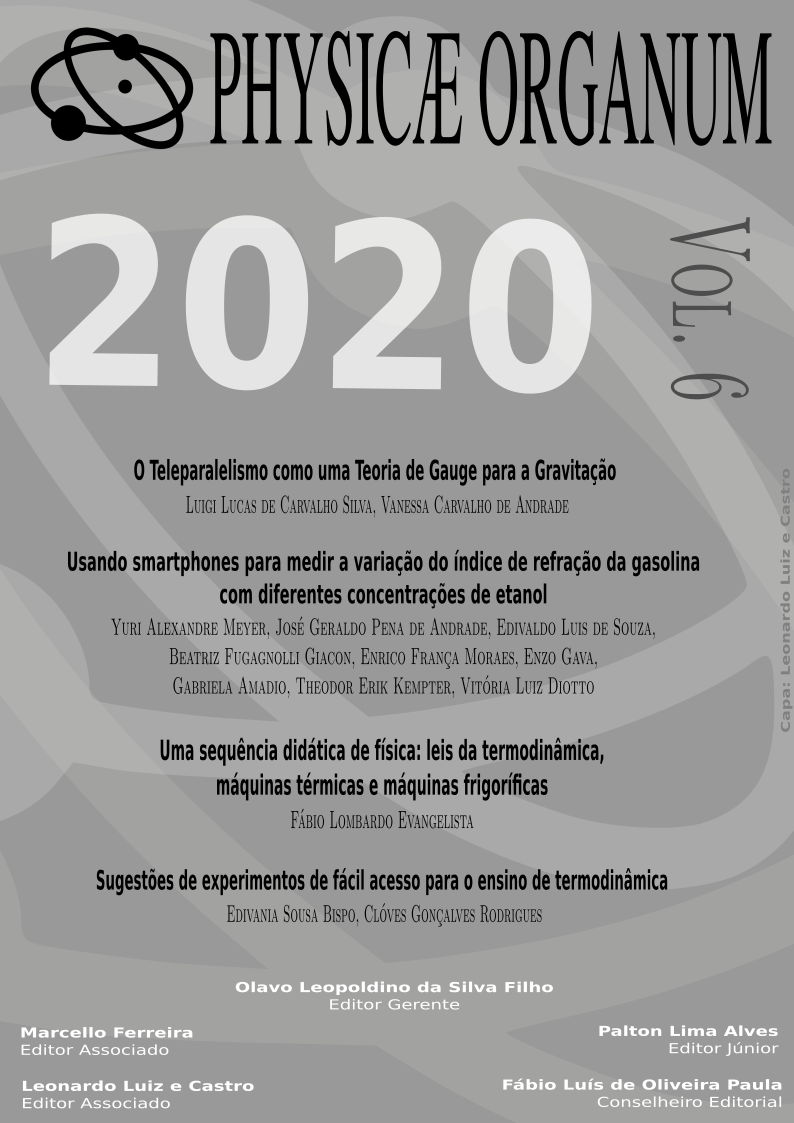A didactic sequence of physics: laws of thermodynamics, thermal machines and coldstorage machines
Keywords:
Physics Teaching, Significant Learning, Mathematical Modeling, Computational Simulator, Low Cost Experiments.Abstract
This work was carried out at the Federal Institute of Santa Catarina, Campus Concordia, in the second year of the Technical Course on Food Integrated to High School. The stage took place in two parts; one of teaching, with five weeks (10 classroom hours), and another of didactic workshop, with two weeks (4 classroom hours). The contents addressed, from a perspective of the Meaningful Learning of David Ausubel, were the Laws of Thermodynamics, Thermal Machines and Refrigerating Machines, contents that are worked out from the curricular teaching plan. Mathematical modeling, virtual simulations in PHET Colorado and low-cost materials were used for this. The stage allowed observing the theory-practice relationship, making it possible to bring diversified methodologies to the classroom. It was also possible to see the contribution to meaningful learning. The students showed an interest in the teaching proposal presented during the classes
Downloads
References
AGUIAR, C. E. Informática no Ensino de Física. Material didático impresso. CEDERJ, 2006. Disponível em http://omnis.if.ufrj.br/ carlos/infoenci/ notasdeaula/roteiros/aula01.pdf, consultado em 5 de junho de 2007.
BASSANEZI, R. C. Modelagem como metodologia de ensino de matemática. In: Actas de la Séptima Conferencia Interamericana sobre Educacíon Matemática. Paris: UNESCO, 1990. p. 130-155.
BÔAS, N,V; DOCA, R,H; BISCUOLA, G, J; Física 2, termologia, ondulatória, ópticas. 3a ed. São Paulo: Editora Saraiva, 2017.
BURAK, D. A modelagem matemática e relações com a aprendizagem significativa. CuritibaBrasil, Editora CRV, 2012, 130 páginas.
CARRARO, F,L; PEREIRA, R,F. O Uso de Simuladores Virtuais do Phet como Metodologia de Ensino de Eletrodinâmica. Paraná: Versão online; OS DESAFIOS DA ESCOLA PÚBLICA
PARANAENSE NA PERSPECTIVA DO PROFESSOR PDE. 2014.volume 1. 18 páginas.
DAROIT, L; et al. O Ensino de fenômenos físicos através da modelagem matemática. X Encontro Gaúcho de Educação Matemática; Ijuí; 8 páginas; julho de 2009.
FERREIRA, P. F. M. Modelagem e suas contribuições para ensino de Ciências: Uma análise do estudo de Equilíbrio Químico. 2006, Dissertação (Mestrado em Educação da UFMG). UFMG, Belo Horizonte.
FILHO, G,FS; Simuladores Computacionais para o Ensino de Física básica: Uma discussão sobre produção e uso.(Dissertação de Mestrado). Rio de Janeiro Instituto de Física- 2010. 86 páginas.
MARTINI, G, et al. Conexões com a física. 2aed. São Paulo: Editora Moderna, 2013. Manual do professor.
MOREIRA, M.A; MASINI, E.F.S. Aprendizagem Significativa, a Teoria de David Ausubel. 2a Edição. São Paulo. Centauro Editora. 2006. 111 páginas.
MOREIRA, M.A. Aprendizagem significativa: a teoria e texto complementares. São Paulo: Editora Livraria da Física. 2011. 179 páginas.
SANTOS, A,M, et al. A importância da realização de experimentos de baixo custo no Ensino Médio. In III CONEDU- Congresso Nacional de Educação. Instituto Federal de Educação Ciência e Tecnologia de Pernambuco ”“ Campus. 7 páginas. 2016.
PELIZZARI, A; et al. Teoria da aprendizagem Significativa Segundo Ausubel.Rev. PEC, Curitiba, v.2, n.1, p.37-42, jul. 2001-jul. 2002.
Downloads
Published
How to Cite
Issue
Section
License
Copyright (c) 2020 Physicae Organum

This work is licensed under a Creative Commons Attribution-NonCommercial-ShareAlike 4.0 International License.
Autores que publicam nesta revista concordam com os seguintes termos:
Autores mantém os direitos autorais e concedem à revista o direito de primeira publicação, sendo o trabalho simultaneamente licenciado sob a Creative Commons Attribution License o que permite o compartilhamento do trabalho com reconhecimento da autoria do trabalho e publicação inicial nesta revista.
Autores têm autorização para assumir contratos adicionais separadamente, para distribuição não-exclusiva da versão do trabalho publicada nesta revista (ex.: publicar em repositório institucional ou como capítulo de livro), com reconhecimento de autoria e publicação inicial nesta revista.
Autores têm permissão e são estimulados a publicar e distribuir seu trabalho online (ex.: em repositórios institucionais ou na sua página pessoal) a qualquer ponto antes ou durante o processo editorial, já que isso pode gerar alterações produtivas, bem como aumentar o impacto e a citação do trabalho publicado (Veja O Efeito do Acesso Livre).




